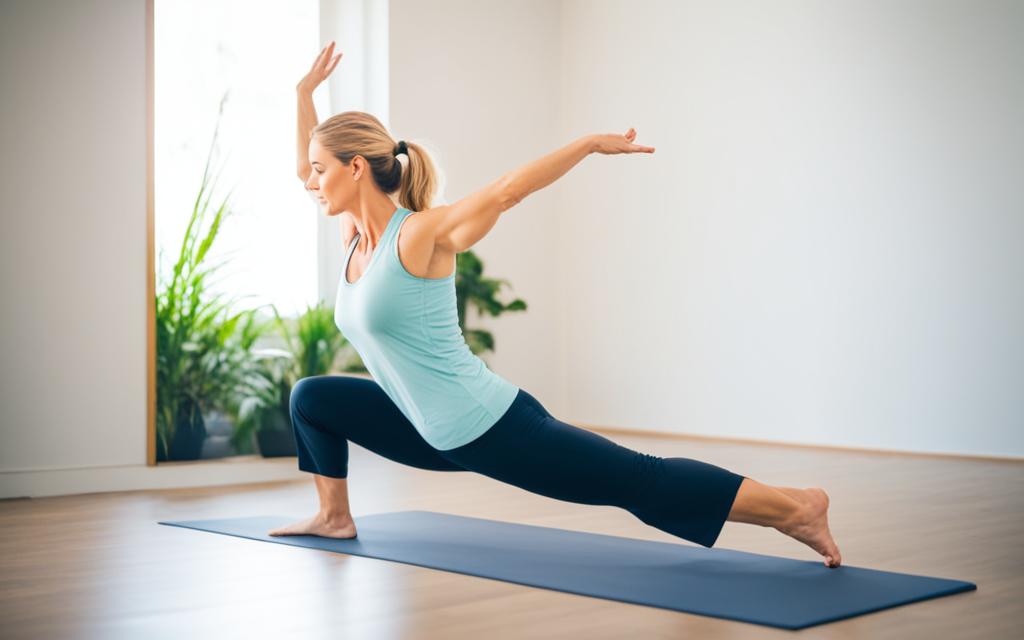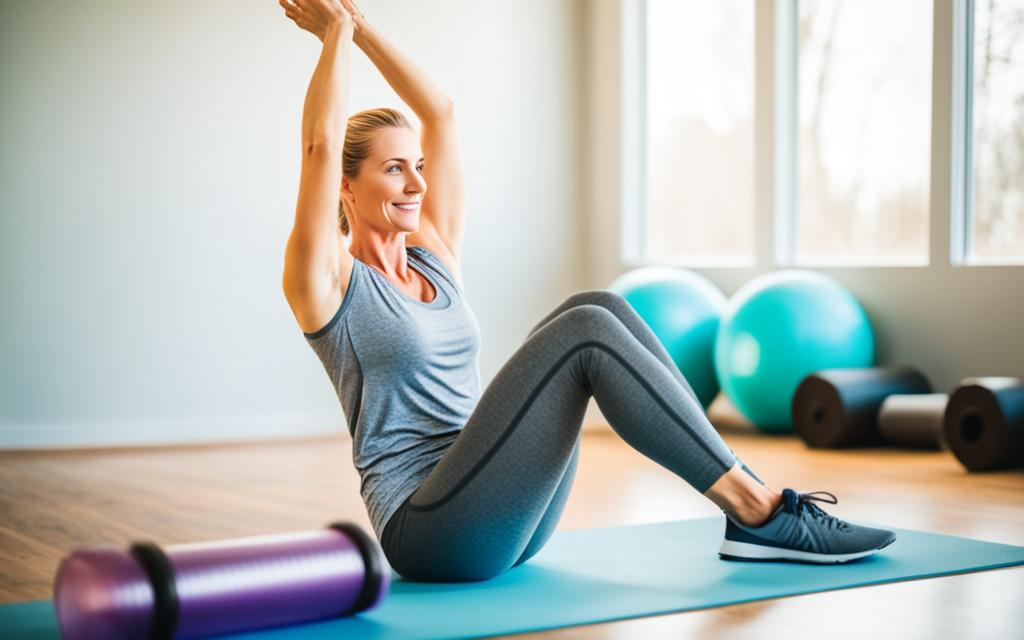After a refreshing massage session, many people feel energized and ready to take on the world. But is it advisable to jump right into physical activity? In this article, we will explore the topic of exercise after a massage and uncover the considerations you should keep in mind to ensure optimal health benefits.
Exercise and massage are both essential components of a healthy lifestyle. While massage can help relax the muscles, improve circulation, and reduce tension, exercise contributes to overall fitness and well-being. But how do the two go hand in hand, and what should you consider before incorporating post-massage workouts into your routine?
In this section, we will delve into the impact of massage on the body, the immediate effects of a massage, and the factors you need to consider before hitting the gym or engaging in any physical activity after your massage. We will also provide expert recommendations on optimal exercise choices and discuss the importance of timing and scheduling.
Remember, it’s crucial to listen to your body’s needs and adjust your fitness routine accordingly. By doing so, you can make the most out of your post-massage workouts and enhance the benefits of your massage sessions.
Key Takeaways:
- Exercising after a massage can complement the benefits of the massage session and contribute to overall health and wellness.
- Understanding the impact of massage on your body is crucial in determining the appropriateness of engaging in physical activity post-massage.
- Factors such as massage intensity, individual fitness level, and specific goals should be considered before exercising after a massage.
- Listening to your body’s cues is essential in identifying if you are ready for a workout and avoiding overexertion.
- Choosing the right types of exercise can further enhance the benefits of a massage and promote recovery.
Now that we have a brief overview let’s dive deeper into understanding the impact of massage on the body.
Understanding the Impact of Massage on the Body
Before we delve into whether you can exercise after a massage, it is important to understand how massage affects the body. Massage sessions provide a variety of benefits that contribute to overall wellness and relaxation.
The Benefits of Massage
Massage therapy is known to have a positive impact on both physical and mental well-being. Here are some key benefits of a massage session:
- Relief from muscle tension and soreness
- Improved blood circulation
- Enhanced flexibility and joint mobility
- Reduced stress and anxiety levels
- Promotion of better sleep
- Release of endorphins, the body’s natural painkillers
These benefits can vary depending on the techniques used during the massage and the individual’s specific needs.
Impact on Muscles and Circulation
During a massage, the therapist applies pressure and kneads the soft tissues of the body, including muscles and connective tissues. This manipulation helps to release muscle tension, improve flexibility, and relieve pain.
Additionally, massage increases blood flow and promotes better circulation throughout the body. This enhanced circulation ensures that oxygen and nutrients reach the muscles more efficiently, aiding in their recovery and overall health.
Regular massage sessions can also help prevent the buildup of lactic acid, a byproduct of muscle metabolism that contributes to muscle soreness and fatigue.
Promoting Relaxation
Massage is widely recognized for its ability to induce relaxation and reduce stress. The soothing touch and gentle strokes during a massage stimulate the production of endorphins and serotonin, which are neurotransmitters associated with feelings of well-being and happiness.
The physical and mental relaxation experienced during a massage can have a lasting impact on one’s overall mood, making it an excellent complement to an active and healthy lifestyle.
Massage therapy provides not only physical benefits but also an opportunity to relax and unwind. Now that we understand the positive impact of massage on the body, let’s explore whether it is advisable to engage in physical activity immediately after a massage session.
The Immediate Effects of a Massage
After a massage, your body experiences a range of immediate effects. These effects can vary depending on the individual and the type of massage received. Understanding these effects is crucial when considering whether to engage in a gym session or workout after a massage.
Muscle Sensations:
One of the immediate effects of a massage is the sensation felt in the muscles. Many individuals experience a sense of relaxation, relief, and increased blood flow to the treated areas. However, some people may also feel temporary muscle soreness or tenderness due to the release of tension and the stimulation of deep muscle tissues. It’s important to pay attention to how your muscles feel and determine if they are ready for further activity.
Impact on Flexibility:
A massage can enhance flexibility and joint mobility by reducing muscle tension. Increased flexibility can be beneficial for various physical activities, including working out at the gym. However, it’s essential to note that excessive stretching or strenuous movements immediately after a massage may lead to muscle strain or injury. A gentle warm-up or stretching routine can help assess your flexibility and avoid overexertion.
Changes in Energy Levels:
Another effect of a massage is the impact it can have on your energy levels. While many individuals feel relaxed and rejuvenated after a massage, others may experience temporary fatigue or drowsiness. This change in energy can affect your ability to perform at your usual intensity during a gym session or workout. It’s important to listen to your body and adjust your exercise routine accordingly to avoid pushing yourself too hard.
Expert Tip: “If you’re planning to work out after a massage, start with a low-intensity exercise to assess how your body responds. Pay attention to any discomfort, pain, or decreased performance. It’s crucial to prioritize your body’s recovery and well-being.” – Dr. Sarah Johnson, Certified Massage Therapist
Understanding the immediate effects of a massage is vital in determining whether it’s appropriate to work out after a massage. It’s important to consider how your muscles feel, the impact on your flexibility, and any changes in energy levels before engaging in physical activity. By paying attention to these factors, you can make an informed decision that promotes your overall well-being.
Factors to Consider Before Exercising After a Massage
Engaging in physical activity after a massage requires careful consideration. While exercise and massage can be a powerful combo for overall well-being, it’s important to assess several factors before incorporating exercise into your routine. Let’s explore these factors to ensure you make the most out of your fitness journey post-massage.
1. Massage Intensity
The intensity of your massage plays a crucial role in determining when it’s appropriate to exercise. Deep tissue massages, for example, can leave your muscles feeling tender and sensitive. In such cases, you may want to allow more time for recovery before engaging in strenuous workouts.
2. Individual Fitness Level
Understanding your individual fitness level is essential when deciding how soon to exercise after a massage. If you have been consistently active and have a higher fitness level, you may feel ready to resume your regular workout routine sooner. However, if you are new to exercise or have any underlying health conditions, it’s advisable to consult with your healthcare professional or fitness instructor to determine the appropriate timeline.
3. Specific Goals for Your Fitness Routine
Consider your specific goals for your fitness routine post-massage. Are you aiming to build strength, improve flexibility, or increase endurance? Tailoring your exercise program to align with your goals can help you derive maximum benefits from both your massage and workout sessions.
Expert Tip: Keep a consistent line of communication with your massage therapist and fitness professional. They can provide valuable insights and guidance to help you make informed decisions regarding exercise after a massage.
4. Listen to Your Body’s Signals
Pay close attention to how your body feels after a massage. If you experience any pain, discomfort, or soreness, it may be an indication that you need more time for recovery. On the other hand, if you feel energetic and refreshed, it may be a sign that you can gradually reintroduce exercise into your routine.
5. Gradual Progression
When incorporating exercise after a massage, it’s essential to start slowly and gradually increase the intensity and duration of your workouts. This allows your body to adapt and prevents overexertion, reducing the risk of injury.
| Factors to Consider Before Exercising After a Massage: | |
|---|---|
| Massage Intensity | Assess the intensity of your massage to determine the appropriate recovery time. |
| Individual Fitness Level | Consider your current fitness level and consult with professionals if needed. |
| Specific Goals for Your Fitness Routine | Align your workout program with the goals you have for your fitness journey. |
| Listen to Your Body’s Signals | Pay attention to how your body feels and adjust your workouts accordingly. |
| Gradual Progression | Start slowly and gradually increase the intensity and duration of your workouts. |
Remember, everyone’s body is unique, and the timing for exercise after a massage may vary. It’s crucial to listen to your body, seek professional advice if needed, and make adjustments based on your individual needs. By considering these factors, you can create a well-rounded fitness routine that complements the benefits of your massage sessions, supporting your overall health and well-being.
Listening to Your Body’s Needs
One of the most important aspects of incorporating exercise after a massage is listening to your body’s cues. Your body will provide valuable feedback on its readiness to engage in physical activity. By paying attention to these signals, you can ensure that you exercise in a way that is both beneficial and safe.
So, how do you know if you are ready for a workout? Here are some key factors to consider:
- Restored Muscle Feel: After a massage, your muscles may feel looser and more relaxed. This is a positive sign that your body is responding well to the treatment. However, if you experience any lingering soreness or discomfort, it may be an indication that you should allow for more recovery time before exercising.
- Energy Levels: Pay attention to your energy levels after a massage. If you feel refreshed and energized, it can be a good indication that your body is ready for some physical activity. On the other hand, if you feel excessively fatigued or lacking in energy, it may be best to prioritize rest and recovery.
- Flexibility: Massage therapy can improve flexibility by releasing tension and increasing range of motion. Before engaging in exercise, take note of your flexibility. If you notice improved flexibility, it may be a good time to incorporate stretching exercises or activities that promote mobility.
While it’s important to push yourself in your fitness routine, be mindful of the signs of overexertion. It’s crucial to avoid pushing your body beyond its limits. Some common signs of overexertion include:
- Severe muscle soreness
- Feeling weak or lightheaded
- Inability to recover quickly during a workout
- Decreased performance or difficulty completing exercises
If you experience any of these signs, take a step back and adjust your fitness routine accordingly. This might involve reducing the intensity or duration of your workout, focusing on low-impact exercises, or simply allowing for more rest and recovery time.
Ultimately, the goal is to maintain an active lifestyle after a massage session. By listening to your body’s needs, you can strike the right balance between exercise and recovery to optimize your overall well-being.

Tailoring Your Exercise Routine
Every individual is unique, and what works for one person may not work for another. To ensure that your exercise routine is tailored to your specific needs, consider consulting with your massage therapist or a fitness professional. They can provide personalized guidance and help you create a post-massage workout plan that aligns with your goals and preferences.
Tip: Remember that gradual progress is key. Start with light exercises and gradually increase the intensity as your body adapts to the post-massage state. This way, you can enjoy the benefits of exercise without risking overexertion or injury.
Stay tuned for the next section, where we will explore the optimal types of exercise to incorporate into your post-massage routine. We will highlight specific activities that can enhance the benefits of your massage and support your active lifestyle.
Optimal Exercise Choices After a Massage
After a rejuvenating massage session, it’s important to choose the right type of exercise to further enhance the benefits of your treatment. Engaging in appropriate physical activity can promote overall well-being and aid in your body’s recovery process. Here are some optimal exercise choices to consider:
- Gentle Stretching: After a massage, your muscles are relaxed and more flexible. Incorporating gentle stretching exercises into your post-massage routine can help maintain and improve your flexibility. Focus on stretching major muscle groups such as your legs, arms, and back.
- Low-Impact Aerobic Activities: Opt for low-impact exercises like walking, swimming, or cycling. These activities provide a cardiovascular workout without putting excessive strain on your muscles. They also help to improve blood circulation, which can enhance the overall benefits of your massage.
- Yoga or Pilates: These mind-body exercises are an excellent choice after a massage. Yoga and Pilates incorporate gentle stretching, strengthening, and breathing techniques, helping to release any remaining tension and promote relaxation.
- Light Resistance Training: If you enjoy strength training, opt for lighter weights and focus on higher repetitions. This approach allows you to engage your muscles without overstraining them. It’s important to listen to your body and avoid lifting heavy weights immediately after a massage.
- Balance and Stability Exercises: Engaging in exercises that improve balance and stability can be beneficial after a massage. These exercises help to realign your body and improve posture, enhancing the effects of your massage.
Remember, it’s crucial to respect your body’s limits and listen to any discomfort or pain. If you experience any unusual sensations or have concerns, consult with your massage therapist or a fitness professional for guidance. Additionally, always stay hydrated and give yourself time to rest and recover after your post-massage workout.
“Choosing the right exercises after a massage can optimize the benefits you receive. Focus on activities that promote flexibility, relaxation, and gentle muscle engagement.”
Timing and Scheduling Considerations
When it comes to incorporating exercise into your post-massage routine, timing and scheduling play a crucial role in maximizing the benefits of both activities. Whether you want to plan your massage session around your workout or determine the ideal time gap between the massage and exercise, here are some guidelines to consider:
Scheduling a Post-Massage Workout
If you prefer to exercise after a massage, it is generally recommended to wait for a certain period before engaging in physical activity. This allows your body to fully absorb the benefits of the massage and avoid any potential discomfort or strain.
While the exact time gap may vary depending on factors such as the intensity of the massage and your individual response to it, a waiting period of at least 12 to 24 hours is often suggested. This ensures that your muscles have adequate time to recover and rejuvenate before subjecting them to additional stress during exercise.
Planning Your Massage Session
If you have a regular exercise routine and want to ensure that your massage does not interfere with it, consider scheduling your massage session strategically. By planning your massage appointments on rest days or after your most intense workout days, you can optimize the benefits of both activities without compromising your fitness goals.
Listening to Your Body
Remember, every individual’s body is unique, and what works for others may not work for you. It’s important to pay attention to how your body feels and responds to exercise after a massage.
“Listening to your body is key in determining when it’s the right time to exercise post-massage. If you’re feeling sore or sluggish, it may be a sign that your body needs more time to recover.”
Be sure to communicate with your massage therapist and fitness professional about your exercise routine and any concerns you may have. They can provide personalized recommendations based on your specific needs and goals.
Celebrating the Benefits
It’s worth noting that taking time for relaxation and self-care through massage is a celebration of your overall well-being. So, whether you choose to exercise before or after your massage, remember to prioritize your health and take pleasure in the benefits of both activities.
| Benefits of Scheduling a Post-Massage Workout | Benefits of Planning Your Massage Session | Benefits of Listening to Your Body |
|---|---|---|
| 1. Enhances muscle recovery | 1. Accommodates your exercise routine | 1. Avoids overexertion |
| 2. Promotes circulation | 2. Maximizes relaxation | 2. Prevents injuries |
| 3. Reduces muscle tension | 3. Allows for optimal performance | 3. Promotes self-awareness |
By finding the right balance between massage and exercise, you can create a post-massage workout routine that supports your journey to optimal health and well-being.

Expert Recommendations and Tips
When it comes to incorporating exercise into your post-massage routine, it’s important to have the right guidance. We’ve gathered expert recommendations and tips to help you make informed decisions and maximize the benefits of your workout.
“Allow your body time to adjust.”
“Start with light exercises.”
“Listen to your body and don’t push yourself too hard.”
Firstly, allow your body time to adjust after a massage session. While massage can enhance circulation and flexibility, it’s essential to give your muscles time to recover from the intense relaxation. Start with gentle stretching exercises or low-impact activities such as walking or swimming.
Next, it’s crucial to listen to your body during your workout. If you experience any discomfort or pain, it’s a sign that you might be pushing yourself too hard. Pay attention to any lingering soreness from the massage and adjust your exercise intensity accordingly.
“Incorporate a combination of cardiovascular and strength training.”
To maximize the benefits of your post-massage workout, consider incorporating a combination of cardiovascular exercises and strength training. Cardio exercises like cycling, jogging, or aerobics help boost circulation and release any remaining tension. Strength training exercises, like weightlifting or resistance training, can help improve muscle tone and build strength.
“Stay hydrated and nourished.”
During and after your workout, it’s crucial to stay hydrated and nourished. Drinking plenty of water helps flush out toxins and replenish your body’s fluids. Fuel your body with nutritious foods that provide the necessary protein, carbohydrates, and vitamins to aid in muscle recovery.
“Consult with your massage therapist and fitness professional.”
Lastly, consult with your massage therapist and fitness professional for personalized advice. Every individual’s body is different, and they can provide guidance tailored to your specific needs and goals. They can help determine the ideal frequency, intensity, and duration of your post-massage workouts and ensure you achieve optimal results.
Take advantage of the expert recommendations and tips shared above to create an exercise routine that complements your massage sessions, promoting overall well-being and recovery.
Post-Massage Workout Tips:
- Allow your body time to adjust.
- Start with light exercises.
- Listen to your body and don’t push yourself too hard.
- Incorporate a combination of cardiovascular and strength training.
- Stay hydrated and nourished.
- Consult with your massage therapist and fitness professional.
By following these tips and focusing on gradual progress, you can optimize the effects of exercise after a massage.
| Exercise Type | Benefits |
|---|---|
| Cardiovascular Exercises |
|
| Strength Training |
|
Conclusion
In conclusion, incorporating exercise after a massage can have significant benefits for your overall health and wellness. The impact of massage on your body, such as muscle relaxation, improved circulation, and increased flexibility, can enhance the effectiveness of your exercise routine.
However, it is crucial to consider important factors before engaging in physical activity after a massage. Factors such as the intensity of the massage, your fitness level, and your specific goals for your workout routine should all be taken into account. Listening to your body’s needs and adjusting your fitness routine accordingly is essential to avoid overexertion and promote optimal recovery.
To ensure the best results, it is recommended to consult with your massage therapist and fitness professional. They can provide personalized guidance and tailor a post-massage workout plan that aligns with your unique needs and goals, maximizing the benefits of both massage and exercise.
FAQ
Can I exercise immediately after a massage?
It is generally recommended to wait at least 24 hours before engaging in intense exercise after a massage. This allows your body to fully benefit from the muscle relaxation and to minimize the risk of injury.
What are the immediate effects of a massage on the body?
After a massage, you may experience improved muscle flexibility, increased blood circulation, reduced muscle tension, and an overall sense of relaxation. However, it is important to listen to your body and adjust your exercise routine accordingly.
What factors should I consider before exercising after a massage?
Factors to consider include the intensity of the massage, your fitness level, and your specific fitness goals. It is important to communicate with your massage therapist and listen to your body’s needs to ensure a safe and effective workout.
How can I listen to my body’s cues before exercising post-massage?
Pay attention to any lingering soreness or discomfort, fatigue, or lack of energy. These could be signs that your body needs more time to recover. Additionally, pay attention to any specific instructions or recommendations given by your massage therapist.
What types of exercise are recommended after a massage?
Gentle exercises such as light stretching, yoga, or low-impact activities like walking or swimming are generally recommended after a massage. These activities can promote relaxation, flexibility, and improve circulation without putting excessive strain on the muscles.
How should I schedule my massage and exercise sessions?
It is advisable to schedule your massage session before your workout, allowing your body to fully benefit from the relaxation and increased blood flow. If scheduling the same day, allow for at least a few hours in between to give your body time to recover.
What are some expert recommendations for exercising after a massage?
Experts recommend starting with gentle exercises and gradually increasing intensity. It is also important to stay hydrated, listen to your body’s needs, and consult with your massage therapist and fitness professional for personalized guidance.




